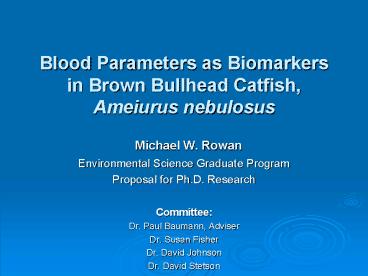Blood Parameters as Biomarkers in Brown Bullhead Catfish, Ameiurus nebulosus - PowerPoint PPT Presentation
1 / 32
Title:
Blood Parameters as Biomarkers in Brown Bullhead Catfish, Ameiurus nebulosus
Description:
Teleost erythrocytes released from erythro-poietic sites at an early ... Blood smears stained with Wright-Giemsa ... methanol, then stain in acridine orange ... – PowerPoint PPT presentation
Number of Views:160
Avg rating:3.0/5.0
Title: Blood Parameters as Biomarkers in Brown Bullhead Catfish, Ameiurus nebulosus
1
Blood Parameters as Biomarkers in Brown Bullhead
Catfish, Ameiurus nebulosus
- Michael W. Rowan
- Environmental Science Graduate Program
- Proposal for Ph.D. Research
- Committee
- Dr. Paul Baumann, Adviser
- Dr. Susan Fisher
- Dr. David Johnson
- Dr. David Stetson
2
Problems with Classical Blood Variables
- Teleost erythrocyte differs from mammalian
erythrocyte therefore use of hematocrit,
hemoglobin, etc. does not convey the same
information as it does for humans - Teleost erythrocytes released from
erythro-poietic sites at an early stage of
development - Mature over time, changing physiologically and
morphologically
3
Blood Parameters as Biomarkers
- Biomarker a xenobiotically-induced variation in
cellular or biochemical processes or functions
that is measurable in a biological system or
sample - Blood parameters are sensitive to environmental
stressors - Blood biomarkers are less invasive
- Fish can be sampled and released without altering
population or community structure
4
Brown Bullhead (Ameiurus nebulosus)
- Ubiquitous benthic catfish distributed throughout
the great lakes - Vulnerable to many hydrophobic contaminants
(PAHs) - Sediment PAHs linked to high tumor rates and
changes in blood variables
5
BROWN BULLHEAD (Ameiurus nebulosus)
6
(No Transcript)
7
Lake Erie Areas of Concern
8
Goals of the Study
- To describe in detail the circulating blood cells
of adult brown bullhead - To compare blood parameters of brown bullhead
populations from contaminated and uncontaminated
sites around Lake Erie - To investigate the use of various blood
parameters as indicators of toxic stress
9
Study Sites
- Ottawa River
- Black River
- Cuyahoga River (upstream)
- Cuyahoga River (harbor)
- Presque Isle Bay
- Huron River
- Old Woman Creek
- reference sites
10
(No Transcript)
11
Methods
- Bullhead collected using fyke nets fished
overnight - Anesthetized with tricaine methylsulfonate
(MS-222) - Mixed arterio-venous blood drawn from caudal
vessels into vacutainer tubes - Blood smears stained with Wright-Giemsa
- Whole blood on ice
- Blood plasma frozen in liquid nitrogen
12
(No Transcript)
13
Potential Blood Biomarkers
- Erythron profiles
- Leukocyte (white blood cell) ratios
- Plasma cortisol levels
- Genetic damage indicators
- (micronuclei analysis, comet assay)
14
Erythron Profile
- An estimation of the relative abundances of red
blood cells in various developmental stages - Mature, intermediate, immature, dividing,
enucleate, karyorrhetic (degenerating)
15
Methods Erythron Profile Image Analysis
- Mocha Image Analysis software was used to capture
random images at 100X - Measurements cell nuclear area cell nuclear
major axis length cell and nuclear minor axis
length cell and nuclear shape factor - Shape factor(4?)(area)/(perimeter2)
(perfect circle has a shape factor 1)
16
Brown bullhead erythrocytes
2
M
1
3
1) Extremely immature erythrocyte 2) 3)
Slightly more developed immature erythrocytes M)
Mature erythrocyte
17
Brown bullhead erythrocytes
M
Int
Int
Int
M
Int) Intermediate erythrocytes M) Mature
erythrocytes
18
Maturity Ratio Estimates
19
Methods (continued)
- To determine the relative number of karyorrhetic,
enucleate, dividing cells, seven fields on the
slide are randomly selected - The total number of each cell type is counted
20
Karyorrhetic erythrocytes
5
4
1
3
2
1) 2) Cytoplasmic swelling 3) 4) Membrane
disintegration nuclear deformation 5) Nuclear
shadow or smudge cell
21
Enucleate Erythrocyte
22
Division of immature erythrocytes
23
Leukocyte Ratios
- Leukocyte numbers are affected by a variety of
physiological and environmental factors - Chronic exposure to contaminants
- - increases number of neutrophils
- - decreases number of lymphocytes
- Methods count 100 total leukocytes per slide,
and record percent neutrophils, lymphocytes,
monocytes
24
Leukocytes
Neutrophil
Lymphocyte
25
Plasma Cortisol Levels
- Cortisol is a hormone that prepares organisms for
the fight-or-flight response - Studies have shown that chronic environmental
stress may reduce the cortisol response to acute
stressors - Experiment designed to determine how capture
methods affect blood parameters
26
Methods Cortisol Experiment
- Capture fish via fyke net acclimate to an
aerated holding tank for 24 hours - Draw blood from each fish four times, at time
0min, 60min, 120min, or 180min - Fish stressed before either first or second
bleeding - Analyze blood smears for erythron profiles /
leukocyte ratios - Freeze blood plasma in liquid nitrogen,
determine cortisol levels by an ELISA
27
Micronuclei Analysis
- Fish erythrocytes contain nuclei
- Easy to obtain DNA samples from small amount of
fish blood look for genetic damage - Micronuclei small abnormalities of the
erythrocyte nucleus, usually caused by
chromosomal damage - Methods
- Fix blood smears in methanol, then stain in
acridine orange - Use fluorescent microscope to record the number
of micronuclei-containing erythrocytes per 2000
erythrocytes
28
(No Transcript)
29
Comet Assay
- Lysed blood cells are placed in an
electrophoresis buffer, DNA is allowed to
unwind - Cells with genetic damage have chromosome
fragments that migrate during electrophoresis,
leaving a tail of damaged DNA - Image analysis used to quantify the length of DNA
migration the percentage of migrated DNA
30
(No Transcript)
31
Significance
- Determining the efficacy of various fish blood
biomarkers - Developing non-invasive methods of acquiring
data, thus preventing further community
disruption in already stressed ecosystems
32
Blood Parameters as Biomarkers in Brown Bullhead
Catfish, Ameiurus nebulosus
- Michael W. Rowan
- Environmental Science Graduate Program
- Proposal for Ph.D. Research

